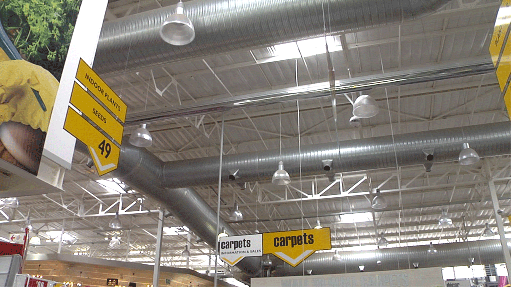
BUILDERS WAREHOUSE, RIVONIA The implementation of LEDs, daylight harvesting cells and evaporative cooling has successfully reduced the store's energy consumption to 89 kWh/m2
South African retailer Massmart is continuing to improve the operating efficiency of its stores by adopting more sustainable technologies, such as light-emitting diodes (LEDs) and daylight harvesting cells for lighting, rainwater harvesting for water supply and evapora- tive cooling technology for temperature control.
During a tour of the company’s 10 176 m2 Builders Warehouse store, in Rivonia, last month, Massmart group sustainability manager Alexander Haw explained to Engineering News that the retail group began independently metering and monitoring energy use in its stores in 2010. This resulted in significant operating efficiency improvements for all its stores, which include Builders Warehouse, Game, Makro and Dion Wired.
Using LEDs and daylight harvesting cells, which are connected to a building management system (BMS), enables the Rivonia store to significantly reduce the amount of electricity it uses for lighting. This is because the daylight harvesting system has light-detecting sensors that enable the BMS to switch to the LEDs when natural lighting is inadequate in the store aisles.
The office areas use compact fluorescent lighting, which is linked to motion sensors that automatically turn off the lights when no one is in an office.
Haw noted that the use of natural lighting in the shopping area of the store also enhanced the shopping experience for customers, as the light was more evenly distributed and did not increase the temperature in the building.
He added that, instead of using energy-intensive heating, ventilation and air-conditioning, the store used an evaporative cooling system, and that, by implementing various energy-saving strategies, Builders Warehouse Rivonia has reduced energy consumption by about 22%, compared with a 2010 baseline of a store of similar size, which also has similar operating requirements.
“A similar-sized store, such as Builders Warehouse Strubensvalley, would, on average, consume about 136 kWh/m2 a year. The Rivonia store successfully reduced this figure to about 89 kWh/m2 in 2014.”
While most Builders Warehouse stores in South Africa employ rainwater-harvesting technology to reduce municipal water consumption, the Rivonia store has, fortunately, been built on a significant borehole water supply.
The borehole water is stored in four 10 000 ℓ tanks and used to supplement the building’s nonpotable water needs, including irrigation for the in-store nursery and the provision of water for the evaporative cooling system.
Haw concludes that, through the implementation of rainwater harvesting tanks across 65 Builders Warehouse stores in South Africa, the franchise has been able to save about 7 000 kℓ/y of water.